| Reviews & Columns |
|
Reviews DVD TV on DVD Blu-ray 4K UHD International DVDs In Theaters Reviews by Studio Video Games Features Collector Series DVDs Easter Egg Database Interviews DVD Talk Radio Feature Articles Columns Anime Talk DVD Savant Horror DVDs The M.O.D. Squad Art House HD Talk Silent DVD
|
DVD Talk Forum |
|
|
| Resources |
|
DVD Price Search Customer Service #'s RCE Info Links |
|
Columns
|
|
|
American Experience: The Amish
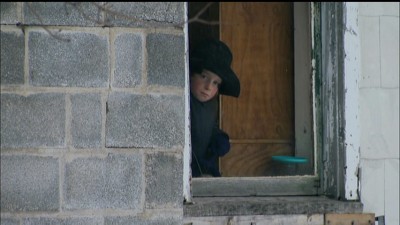
It seems likely that interest in the Amish -- those East-of-the-Midwest Pennsylviania-Dutch descendants we all have a vague and often probably not very accurate idea of -- was sufficiently renewed to warrant a two-hour PBS special by the horrendous events of October 2, 2006, when a gunman killed five young Amish girls in a Southeast Pennsylvania schoolhouse and added insult to injury by bringing in a wave of the kind of media attention that these rural, quiet, pious, very purposefully insular people would loathe more than anyone. But much like the community itself (which, rigorously true to their beliefs, rejected all vindictiveness, forgave, bore up, and moved on in the face of this tragedy), David Belton, the writer/director of The Amish, refuses to let such an anomalous, horrific outside intrusion disrupt or steal undue attention away from the much farther-ranging subject at hand: a religious tradition that has existed on American soil since long before there was a United States and has, miraculously, held fast to its core veneration of family and hard work, along with its unwavering suspicion of technological conveniences, war, and worldliness, throughout American history, right through the industrial revolution and up to the present day, when these folks, now tentatively beginning to look west for true rural isolation, still refuse to possess telephones, automobiles, TVs, or cameras even while many of our era's most popular "churches" broadcast their services via satellite.
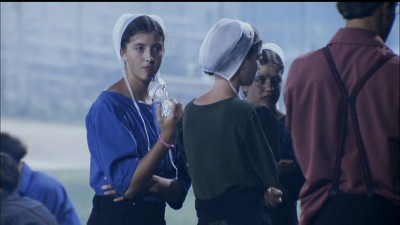
Belton starts us off the same way most people whose curiosity draws them into the rural Amish areas of Ohio, Indiana, New York, and, especially, Pennsylvania, are likely to begin their journey -- on a tour bus full of people looking out the window in wonder at the beautifully tended, solid, simple, and meticulously crafted farms and homes that the Amish create through their intensively hard labor, done almost entirely the old-fashioned way, without the aid of technological innovations. This seen-through-the-glass aspect is an important part of the Amish story: they keep to themselves, meticulously holding the world at a distance, even calling the non-Amish "English" hundreds of years after that description lost its strict accuracy, and yet this group of people, who number around 250,000 total, create and inhabit a world that 20 million tourists come annually to gawk at, whether in pity, admiration, envy, or curiosity. They are not, of course, interacting with most Amish (other than, as we see, the few who do demonstrations and run the (manual) cash register at a tourist shop): their view is of the outward manifestations of a way of life that is by now completely foreign to the non-Amish but surely seems paradisiacally peaceful, if nothing else, to all of us who probably couldn't even articulate all of our whirling needs, wants, and complications out here in the world of career ambitions, cascading technological advances, and full-to-bursting schedules.
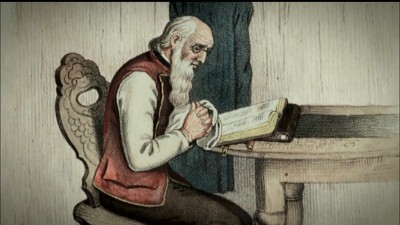
But, through the long cultivation of trust and mutual respect with the camera-averse people within these communities, Belton and his team have enabled themselves to give us much more than just the impressively solid, practical, simple yet strikingly beautiful products -- the sturdy homes and well-built barns, the horses and buggies -- of Amish beliefs and practices. Most of the faithful still won't appear directly on camera, but we are allowed to see them, even their faces, from a distance: the men at work in the fields, the children going to school, the freshly cleaned and organized rooms inside and the neatly hung laundry outside of a home, or a 16-year-old girl in silhouette as her voiceover tells us about the nervousness but mostly joy she feels as she anticipates her upcoming baptism, when she will publicly enter into adulthood with the promise to be a part of the Amish community and adhere to its rules once and for all. In addition to these privileged, close-in scenes of Amish life and the accompanying voices articulating the communities' core beliefs and practices and recounting, shyly and hesitatingly, their personal, inner experiences and impressions of an existence led in this way (along with archival educational-film and news-program footage revealing the evolution of popular-culture attitudes toward the Amish, as well as the awful post-schoolhouse-massacre video we all saw in 2006, put in context here with voiceover commentary from some of the Amish who lived it), Belton presents us with testimony from experts from outside of the Amish community who have made this particular, longstanding practice of Christian faith their special focus of study: historians Steven Nolt and David Weaver-Zercher, anthropologists Karen M. Johnson-Weiner and Gertrude Huntington, all of whom contribute knowledgeable and objective descriptions of the Amish history of persecution in Europe and consequent escape to the New World's religious freedom; Amish customs like the diverse Ordnungs, the unwritten laws specified by each Amish church for its 25-35 member families (a memorable example pointed out is that one church can forbid bicycles while another group of Amish a mile down the road are free to bike); and an oft-misunderstood period in late Amish adolescence called rumspringa, which is less a sewing of wild oats than just being allowed to act like teenagers -- roaming in packs, smoking, dating, indulging in forbidden worldly things like cell phones and rock music -- before their baptism and effective renunciation of the outside world.
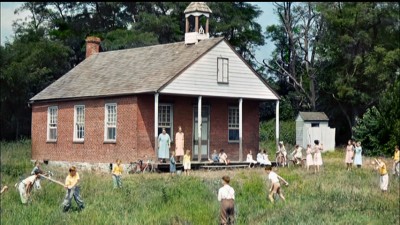
Also among the experts interviewed are -- importantly for rounding out points of view on what is, after all, a very strict religious sect -- some Amish dissenters, those who were raised within the community and have made the conscious and painful decision to leave the Amish life behind: a woman named Saloma Furlong who describes the agonized decision and extremely painful process of separation she undertook when she found the Amish stopping-short of education at eighth grade and general refusal to brook questions about its prohibitions too unsatisfying and disillusioning; and a young man of about 20, Levi Shetler, who left the faith when he was 17 for similar (if less intense) reasons of feeling cut off from the freedoms the outside world hold. Both of these former Amish have suffered some form of "shunning" (Furlong's much more extensive, sad, and troubling than Shetler's), which comes from the "tough-love" dark side of Amish insularity and unbreakable community: You are encouraged to be baptized after your rumspringa, but the choice is entirely yours; however, once you make that promise to God and your church brethren, breaking it cuts you off, often even from speaking to family members, until such time as you renew it without reservation (a twist of the knife is the practice, known to all Amish, of continuing to set a place at the table after a member has left, so wherever they are in the world, they know there's an empty spot they've abandoned). Most human group formations, to be fair, have similar terms and trade-offs, but the stakes are extremely high, the punishments severe, when it comes to the Amish's grave considerations of family and community, the parts of life they value most highly by far (hence their rejection of the telephone, which means you don't have to visit your neighbors in person), and which must not be broken in any way.
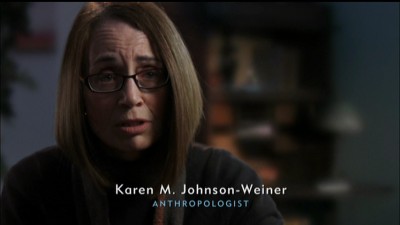
The way Belton and his creative team, cinematographer Tim Cragg, editor Chyld King, and composers Saunder Jurriaans and Baniel Bensi, approach the subject is unusual for a documentary, especially one made for television, but fitting to the uniqueness and ultimate unknowability, however much we can learn about their history and ways, of the purposely anachronistic and (enviably?) private Amish. There's almost a degree of abstraction that's achieved in The Amish, which comes about mostly through the stunning visuals, frames so well composed and with such adept use of exterior light, it's no wonder cinematographer Cragg's name is the first credit to appear in the opening titles. Jurriaan and Bensi's score, occasionally veering a bit to the sentimentalizing side, is for the most part a truly beautiful kind of Arvo Pärt homage whose unexpected notes and tempos underscore the rich complexities and contradictions of what we're discovering, not just the postcard-from-Amish-country quality Belton and Cragg wisely avoid. The Amish ultimately doesn't allow us to feel we've summed up or figured out the whys and wherefores of the Amish, but it does refreshingly open up a new path of inquiry and consideration for us when it comes to a group of Americans too often misrepresented, poorly understood, or easily dismissed. It's food for thought and an opportunity for reflection on how divergent have been the paths of the Amish and the rest of us (which hewed quite closely to one another before steam, electricity, and assembly lines radically altered things); through the 19th century, Amish and "ordinary" Americans had more in common than not, but before most anyone alive today was born, the vast majority of Americans chose the way of technological innovation, comfort, and consumerism. And if a case can be made for the advancements and progress that way has led to, we're reminded here that it was a trade-off in some important respects; the enduring fascination of the Amish, and the value of The Amish, comes from their affording us a rare opportunity to actually see and consider what the other route might have looked like.
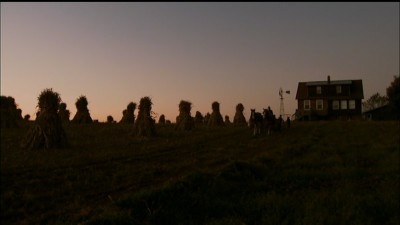
THE DVD:
Tim Cragg's often extraordinarily beautiful high-definition digital videography for the Amish-country footage and the interviews with the experts, along with the archival footage and its native TV news-video and/or old-celluloid defects, all come through on this disc's anamorphic, approximately 1.78:1 aspect ratio transfer (there is an unusual, very slight cropping at the top of the frame that puts the actual AR somewhere between 1.78:1 and 1.85:1) looking just as they should -- one of the benefits of working with digital video. Cragg's DV achieves an extraordinarily "cinematic" quality for this type of program; no information is given, but one could almost believe Cragg and crew were using one of those top-quality, highly advanced RED digital video cameras that Soderbergh used for Che, and Todd Solondz for Life During Wartime. As to the nitty-gritty potential flaws, there is virtually no aliasing or edge enhancement; a nice job all around.
Sound:The Dolby Digital 5.1 soundtrack is very good. All the voices, music, and background sound have a depth, clarity, and resonance to them that are unbroken at any moment by distortion or imbalance.
Extras:Just an extremely brief "Behind the Scenes" that seems to have been designed more as a promo spot for The Amish's airing than anything very in-depth; it does, however, contain some reflective thoughts on the program and its subject from American Experience executive producer Mark Samels, director David Belton, and producer Callie T. Wiser.
FINAL THOUGHTS:The Amish can only get us so close to its subject, a group whose religious beliefs severely limit their ability to appear in front of the camera. But it does take us, on the visual level, as far into the world of the Amish as we have ever been, and that world is one that is at once forbidding, mysterious, alluring, and beautiful for being all the things that our world isn't: calm, ordered, quiet, very hardworking but utterly unpressured, as its inhabitants simply know with certainty what they are required to do and do it, with the aim of spiritual and mental well-being for all. That air of Walden-like "naturalness" is not, of course, the whole story, and director David Belton stops just short of romanticizing it, through all the film's pretty views of plain, healthy people appearing to live in harmony with gorgeous nature (the sheer visual splendor of the Amish country must account for a large proportion of its many tourists), by also including stories of those who have opted out of a strict life that demands some severe, perhaps unfair sacrifices in exchange for the kind of happiness it can bring. Paradoxically, the Amish's refusal to appear on camera for interviews (though they are seen from distances and have allowed their voices to be recorded) gives the filmmakers ample opportunity to obey the cinematic imperative to "show, don't tell," and the film sometimes even takes on a Terence Malick-like feel with the slow, self-conscious, patiently narrating voices of Amish men and women explaining to us their beliefs, theology, and rules and habits of dress, interaction, education, and work over direct but lovingly composed images of clean, simple, starkly beautiful Amish households and hard, orderly tilling out in the fields, frequently captured in the golden light of dawn or dusk. That contemplative aura is very apt for such an unusually impressionistic, evocative documentary, which takes for its subject an elusive, unworldly, spiritual, but very practical people. The Amish doesn't presume to explain definitively how this idiosyncratic, resilient, fascinatingly genuine group of devout religionists has been able to survive for so long within yet quite apart from the industrialized world, but it does take us along for an open-minded, in-depth, and attentive exploration of how their belief systems and way of life came about, their trials and triumphs over the centuries, and the troubling uncertainty of their present and future. It's a journey that withholds opinionated commentary or judgment but sheds some engaging, intriguing light, both on the Amish and perhaps -- because they define themselves against what they see as our convenient and indulgent yet soulless, distracted, disconnected world -- on us, too. Recommended.
|
| Popular Reviews |
| Sponsored Links |
|
|
| Sponsored Links |
|
|
| Release List | Reviews | Shop | Newsletter | Forum | DVD Giveaways | Blu-Ray | Advertise |
|
Copyright 2024 DVDTalk.com All Rights Reserved. Legal Info, Privacy Policy, Terms of Use,
Manage Preferences,
Your Privacy Choices | |||||||













